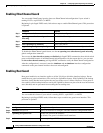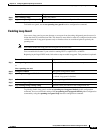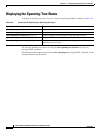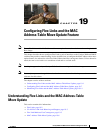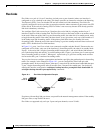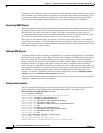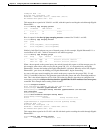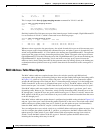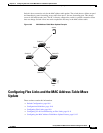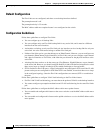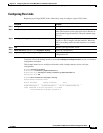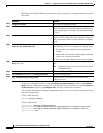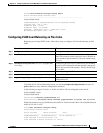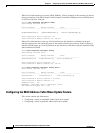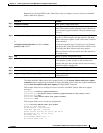
19-6
Catalyst 2960 and 2960-S Switch Software Configuration Guide
OL-8603-09
Chapter 19 Configuring Flex Links and the MAC Address-Table Move Update Feature
Understanding Flex Links and the MAC Address-Table Move Update
-------------------------------------------------------------
1 1.1.1.1 v2 Gi0/11
401 41.41.41.1 v2 Gi0/11
This is output for the show ip igmp snooping mrouter command for VLAN 1 and 401:
Switch# show ip igmp snooping mrouter
Vlan ports
---- -----
1 Gi0/11(dynamic), Gi0/12(dynamic)
401 Gi10/11(dynamic), Gi0/12(dynamic)
Similarly, both the Flex Link ports are a part of the learned groups. In this example, Gigabit Ethernet0/11
is a receiver/host in VLAN 1, which is interested in two multicast groups:
Switch# show ip igmp snooping groups
Vlan Group Type Version Port List
-----------------------------------------------------------------------
1 228.1.5.1 igmp v2 Gi1/0/11, Gi1/0/12, Gi2/0/11
1 228.1.5.2 igmp v2 Gi1/0/11, Gi1/0/12, Gi2/0/11
Whenever a host responds to the general query, the switch forwards this report on all the mrouter ports.
When you turn on this feature through the command-line port, and when a report is forwarded by the
switch on GigabitEthernet0/11, it is also leaked to the backup port GigabitEthernet0/12. The upstream
router learns the groups and starts forwarding multicast data, which is dropped at the ingress because
GigabitEthernet0/12 is blocked. When the active link, GigabitEthernet0/11, goes down, the backup port,
GigabitEthernet0/12, begins forwarding. You do not need to send any proxy reports because the
multicast data is already being forwarded by the upstream router. By leaking reports to the backup port,
a redundant multicast path has been set up, and the time taken for the multicast traffic convergence is
minimal.
MAC Address-Table Move Update
The MAC address-table move update feature allows the switch to provide rapid bidirectional
convergence when a primary (forwarding) link goes down and the standby link begins forwarding traffic.
In Figure 19-3, switch A is an access switch, and ports 1 and 2 on switch A are connected to uplink
switches B and D through a Flex Link pair. Port 1 is forwarding traffic, and port 2 is in the backup state.
Traffic from the PC to the server is forwarded from port 1 to port 3. The MAC address of the PC has
been learned on port 3 of switch C. Traffic from the server to the PC is forwarded from port 3 to port 1.
If the MAC address-table move update feature is not configured and port 1 goes down, port 2 starts
forwarding traffic. However, for a short time, switch C keeps forwarding traffic from the server to the
PC through port 3, and the PC does not get the traffic because port 1 is down. If switch C removes the
MAC address of the PC on port 3 and relearns it on port 4, traffic can then be forwarded from the server
to the PC through port 2.
If the MAC address-table move update feature is configured and enabled on the switches in Figure 19-3
and port 1 goes down, port 2 starts forwarding traffic from the PC to the server. The switch sends a MAC
address-table move update packet from port 2. Switch C gets this packet on port 4 and immediately
learns the MAC address of the PC on port 4, which reduces the reconvergence time.
You can configure the access switch, switch A, to send MAC address-table move update messages. You
can also configure the uplink switches B, C, and D to get and process the MAC address-table move
update messages. When switch C gets a MAC address-table move update message from switch A,
switch C learns the MAC address of the PC on port 4. Switch C updates the MAC address table,
including the forwarding table entry for the PC.



